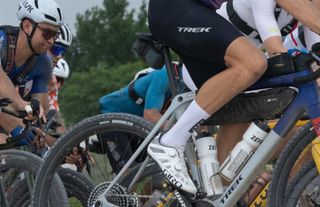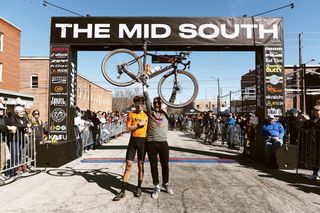Welcome to 2025, and join us as we explore what might be new and exciting in the world of gravel cycling this year.
But here’s the twist: we’re not playing it safe. We’re not being coy or holding back—no, this year, we’re being bold, loud, and we’ll probably be wrong about a thing or two.
But that’s the fun of it. Predictions should be about bold guesses, not safe bets. So, without further delay, here are six increasingly bold predictions for gravel cycling in 2025.
Keegan Swenson will take his fourth crown at the Life Time Grand Prix
(Image credit: USA Cycling)
Alright, we’ll admit it—this first one’s a pretty safe bet but hold off on the eye-rolls. This “safe” pick is the perfect stepping stone for getting bolder as we dive deeper into the list.
That said, Keegan Swenson winning the Life Time Grand Prix in 2025 may not be as certain as you might think —and that’s more to do with the series than Swenson himself.
New in 2025, the series will sport a few changes that might count against Swenson. Firstly, there will be less racing at altitude. With Rad Dirt Fest and Crusher in the Tushar nixed from the series line-up, Swenson has two fewer opportunities to showcase his dominance in the mountains. Leadville remains as the only high-altitude race.
Secondly, there is more international talent. The series has added several former WorldTour pros to the lineup in an effort to make the series more worldly, which undoubtedly raises the potential power in the men’s field.
The latest race content, interviews, features, reviews and expert buying guides, direct to your inbox!
Still, the new faces aren’t known mountain bikers, and three of the series events will be fought on the gnarly stuff where Swenson’s background serves him well.
While there are other fantastic mountain bike athletes in the line-up, few seem to have the measure of both disciplines to the extent Swenson continues to hold. What’s more, if we can learn anything from Swenson over the years, it is that when a challenge arises, few are better at tackling it with the same level of attention and innovation as the man from Utah.
The best gravel race tyres are mountain bike tyres

(Image credit: Snowy Mountain Photography)
There will be more on this topic on this site soon, but it is an open secret that the definition of what a gravel tyre is has already changed. The 38-42mm tyres that have reigned supreme in years past are now gone from the front of races. Within a year, tyres have ballooned to 50mm and beyond. Given the success and the vocal evangelising of a few top names, that trend is here to stay, at least for the season ahead.
While some drop bar bikes can now accommodate a 2.25-inch tyre, those are still the exception. Still, 2.25-inch tyre options are becoming more widely available, and this year, it seems the answer to the “best gravel tyre” question is simply: the biggest one you can run.
Independent races will gain popularity

(Image credit: 241Photography)
Gravel racing has built itself on name brands. Organisations like Life Time, BWR and SBT GRVL have built reliable brands with repeatable formats, and now put on multiple events throughout the year and around the globe. These events have been crucial to the growth of the sport and its recognition abroad.
Does that mean that the big series will diminish? That is less clear. Life Time has, undoubtedly, several gravel events backed with the popularity to keep them around for a while. Yet the fate of less popular events like Crusher in the Tushar and the Rad Dirt Fest are less clear, especially now that they’ve been booted off the Life Time Grand Prix calendar.
SBT GRVL persists, but every year, the race faces stronger headwinds in its local Routt County. And its Finnish and Australian offshoots have yet to cement themselves on the global calendar the way the original event has.
Yet, beyond the big names, there are many fantastic races that are run by local organisations and are starting to earn a loyal following. Races like the Oregon Trail Gravel Grinder, Gravel Worlds, FoCo Fondo, and Mid South continue to build momentum and add new aspects to their charm.
As folks check off the big challenges and continue to invest in the sport, those independent races will continue to see their popularity tick up.
Unorthodox equipment will continue to push the limit of style and function in the pursuit of gains

Keegan Swenson used drop bars on his mountain bike at the 2024 Leadville 100 race
(Image credit: Life Time)
One of the enduring debates of gravel cycling in the years past has been aerobars. Thankfully, for the safety of many and the sanctity of drop bar bikes, that debate has mostly been settled. They have made their way out of most mass-start gravel races. Yet tech debates and what belongs or what doesn’t in gravel races will not go away.
Drop bars on mountain bikes, suspension on gravel bikes, helmets, fairings, water containers, tall socks, and deep dish wheels are all part of the fray as people sort through ways to get faster in the biggest gravel races.
Nothing is likely to be as controversial as aero bar extensions, but ludicrous aesthetics do get the people fired up (looking at you, Giro time trial helmet).
We cannot wait to see what style rules will be broken in the pursuit of speed in 2025. And we’re certain we’ll have lots to talk about. Gravel is, after all, cycling’s Wild West.
Live coverage will take a leap in gravel race coverage

(Image credit: Getty Images)
When Gravel Worlds —the annual race in Nebraska, not the UCI event— announced it would have wall-to-wall live coverage of its race, many folks were sceptical. Who’s going to want to watch a 150-mile gravel race through the farm fields of Nebraska? On paper, that proposition sounded, well, boring. But in reality, it is fascinating and refreshing.
While I did not watch the race in its entirety in 2024, it was brilliant to drop into the stream throughout the day to follow the action. I saw how the race played out in both big and small moments. I was delighted to see how different riders caught my eye and to experience the minutiae of the endurance test of gravel racing — something you don’t get in the snippets of race recaps and Instagram stories.
Now, Nebraska is blessed with a few important things. First and foremost, the state offers excellent cell and internet coverage, which makes live streaming possible—something other places can’t always replicate. Still, Gravel Worlds proved that live coverage of gravel racing can bring fans into the action in a meaningful way, and that’s something with undeniable potential.
Unbound’s race tactics will reshape gravel racing – for better or for worse

The women’s race at Unbound Gravel in 2024 came down to a thrilling seven-person sprint.
(Image credit: Snowy Mountain Photography)
At last year’s Unbound event, seven women came to the line together. Each rider had her own sponsors and her own objectives and had set out 200 miles earlier in search of her own glory. Or at least, that is how it would have been if the race had followed the script of gravel racing up until that day.
Yet, in the finishing straight, something else happened. American Sarah Sturm appeared to be conducting a leadout for Dutchwoman Geerike Schreurs, a rider who’s part of the Specialized family but on a different team.
In road racing, leadouts are commonplace but in gravel racing, and Unbound specifically, the racing has historically never played out that way. Team dynamics aren’t really a thing – yet- but odds are they will be in some very important circumstances. With talk of sponsors offering race bonuses and prize purses growing in gravel races, we’re likely to see more quasi-team tactics and dynamics.
We say “quasi” because gravel racing isn’t suited for team tactics as we know it. For one, there aren’t the resources (yet) to support domestiques. In the privateering landscape of gravel, it’s still very much every rider for themselves. Second, the technicality of the courses and the sheer attrition of the races don’t allow for the same numerical advantages as road racing does.
Unbound, however, appears to be the exception. The prestige, sponsor incentives, and exposure are big enough that riders are willing to form allegiances, even if it means missing out on the win themselves. What’s more, the depth of talent at this race has gotten to the point where group racing has become the norm and having an ally (even if you’re not wearing the same kit) at the end of the race is a more reliable possibility.
Unbound continues to be the testing ground for innovations – in tech and tactics alike. If something is successful here, it sets the precedent for races to come. So keep your eyes peeled at Unbound as we’re likely to see new developments in race tactics this year. And then, watch as those evolutions begin to creep in elsewhere in the calendar. If that is the case, big changes –and big existential, ‘spirit of gravel’-type debates – will likely follow.